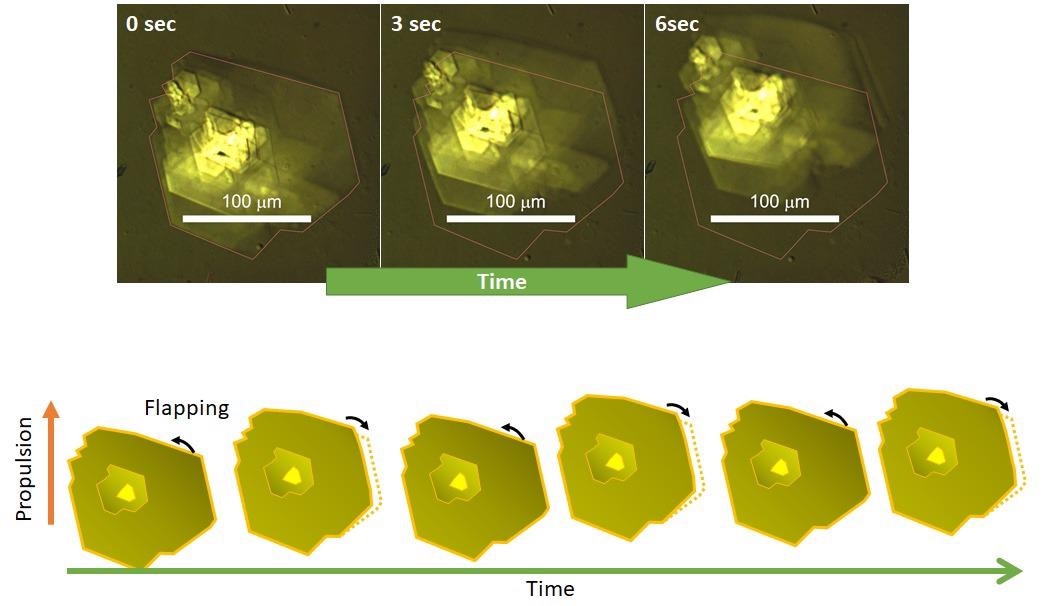As demonstrated by the famous physicist Richard Feynman, developing molecular microrobots that simulate the capabilities of living organisms seems to be a dream of nanotechnology.
 (Above) A series of light micrographs showing the movement of one of the synthesized microrobots in this study. (Below) A representation of the movement of the fin over time. Image Credit: Kazuma Obara, Yoshiyuki Kageyama, Sadamu Takeda, Small, November 27th, 2021.
(Above) A series of light micrographs showing the movement of one of the synthesized microrobots in this study. (Below) A representation of the movement of the fin over time. Image Credit: Kazuma Obara, Yoshiyuki Kageyama, Sadamu Takeda, Small, November 27th, 2021.
There are several difficulties in achieving this target. One of the most considerable among these is achieving directed self-propulsion in water.
A group of three researchers from Hokkaido University, headed by Assistant Professor Yoshiyuki Kageyama, has been successful in making a microcrystal that uses self-continuous reciprocating motion for propulsion. The findings of the study were reported in the journal Small.
The dream of microrobots dates back several years, discussed in science fiction for several decades, and familiarized by the advent of nanotechnology. One feature of these robots is self-propulsion, the potential to move self-sufficiently.
There are two significant difficulties to achieving this: the first one is to create a molecular robot that has the potential to reciprocally deform, and the second is transforming this deformation into propulsion of the molecular robot.
The team led by Kageyama built on their early research that had resolved the first difficulty — the creation of molecular robots that can deform reciprocally. But small objects lose their ability to convert their reciprocal motion into progressive motion, in general, as described by Edward Purcell’s scallop theorem.
In the present study, the researchers went a step ahead and were successful in identifying the self-propulsion of the molecular robot in an experimental system where motion was limited to two dimensions; in this system, viscous resistance serves anisotropically, thus making it slightly weak.
Driven by blue light, the microrobot induced a range of reactions, resulting in the propulsion and fin flipping. As a result of the nature of the reactions, the motion was not consecutive but occurred irregularly.
The molecular robots exhibited one of three distinct styles of propulsion: a “stroke” style, with the fin in front; a “side-stroke” style, with the fin to one side, or a “kick” style, with the fin behind. The nature of mobility was impacted by the area of the fin and its angle of elevation; separate crystals propelled themselves in various styles and directions.
Furthermore, the scientists made a computational minimum model to comprehend the variables that impacted the propulsion in a two-dimensional tank. They were able to identify that fin ratio, fin length and elevation angle were the main variables that tend to affect the direction and the pace of propulsions.
The result, which demonstrated that tiny flappers can swim assisted by the anisotropy caused by confined spaces, could spur research into molecular robots. A similar mechanism may be in the movement of small aquatic organisms in specific conditions such as inside eggs.
Yoshiyuki Kageyama, Assistant Professor, Faculty of Science, Hokkaido University
This study was financially supported by the Japan Society for the Promotion of Science (JSPS) KAKENHI in Scientific Research on Innovative Areas “Molecular Engine” (JP18H05423) and in Scientific Research on Innovative Areas “Discrete Geometric Analysis for Materials Design” (JP20H04622); and by the Ministry of Education, Culture, Sports, Science and Technology (MEXT) via the Program for Leading Graduate Schools (Hokkaido University “Ambitious Leader’s Program”).
Journal Reference:
Obara, K., et al. (2021) Self-Propulsion of a Light-Powered Microscopic Crystalline Flapper in Water. Small. doi.org/10.1002/smll.202105302.